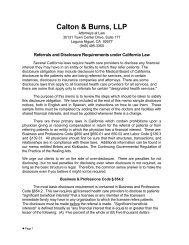Enhancing Your Practice's Revenue - California Orthopaedic ...
Enhancing Your Practice's Revenue - California Orthopaedic ...
Enhancing Your Practice's Revenue - California Orthopaedic ...
- No tags were found...
Create successful ePaper yourself
Turn your PDF publications into a flip-book with our unique Google optimized e-Paper software.
careful planning, creation of a realistic business plan andimplementation of a good governance structure.• JV arrangements need to be developed with great care toensure compliance with government regulations.• As far as compliance is concerned, the greater numberof stakeholders, the more important it is to “dot all theI’s and cross all the T’s (and the more difficult this canbecome).• The blueprint for the initiative must include amechanism for addressing disagreements, since these aresure to arise over time.• All JVs must include a mechanism for “unwinding”because times change and circumstances change(including federal and state regulations); nothing lastsforever.Contact: Frederick Meyer, MD: freddoc937@me.comChapter 9Service Line Co-ManagementBy Craig Mahoney, MDWhat Exactly Is Service Line Management?In today’s healthcare environment, hospitals are realizingthat they cannot be all things to all people. Given limitedresources, it is not possible for them to provide a fullrange of high-quality medical services to everyone inthe community in a cost-effective manner. They areincreasingly focusing their human and capital resources onwhat are now referred to as “service lines.” A service lineis a group of services that relates to the treatment of a setof diseases, disorders and/or conditions. Resources can befocused and coordinated around specific groups of patients.Service line management (SLM) covers all the activitiesthat go into overseeing a given service line. This includes(a) what clinical functions should be included, (b) requirementsfor physician and allied health staff, (c) requirementsfor equipment and space, and (d) back-office supportactivities; e.g., billing and collections.The introduction of SLM to the healthcare field beganin the early 1980s; the impetus was implementation ofthe prospective payment system (PPS). PPS resulted in asea-change in terms of the way hospitals were paid. Patientsadmitted into the institutions had to be classified into “diagnosisrelated groups” or DRGs. DRG payments receivedfrom government agencies covered all the services to patientsduring their stay. Thus, management of costs becameextremely important because reimbursement, except underunusual circumstances, was fixed.By grouping related services together into service lines,hospitals were able to calculate total revenues and totalcosts associated with the lines. This allowed them to decidewhich lines they wanted to focus on, at least from a financialstandpoint. The approach is not dissimilar to Ford MotorCompany looking at the profitability of one car model,for example, relative to another one, and making decisionsregarding the models’ futures.A: High Profitability B: Low Profitability1. High Volume A1 B12. Low Volume A2 B2Service lines can be classified as high volume-high profitability;high volume-low profitability; low volume-highprofitability; and low volume-low profitability.Each hospital needs to determine where the services itoffers fall in the above grid. <strong>Orthopaedic</strong>s and cardiologyalmost always fall into quadrant A1. Medical services typicallyfall into quadrant B2.It makes economic sense to actively manage service linesin quadrant A1 because this will maximize cash flow for theinstitution as a whole. That in turns means that the additionalcash can be allocated to other arenas. The old adagethat “a hospital full of patients is always a profitable one”is not true if many of the patients suffer from conditionsthe institution cannot treat in a high-quality, cost-effectivemanner.Note: focusing on service lines such as orthopaedics doesnot mean that other service lines should be ignored. Forexample, if a service is high volume-low profitability (B1),managers should be looking at ways to inrease profitability,either by improving revenues or eliminating (unnecessary)costs. By the same token, if a service line is low volumehighprofitability (A2), managers should be looking at waysto increase volume. If the hospital wishes to continue tooffer low volume-low profitability services (B2), it is criticalto move as many other service lines as possible into the A1quadrant, and actively manage them. The more money ahealthcare institution generates from high volume-highprofitability services, the more it will be able to continue toserve the community in other arenas.Advantages of Service Line ManagementThere are numerous advantages to service line managementincluding:• Coordination of care among related clinical areastranslates to improved overall quality of care.• <strong>Revenue</strong>s and costs can be aligned to determine serviceline profitability.• Traditionally independent “silos” (e.g., nursing, imaging,PT/OT) start working together.32© 2011 American Academy of <strong>Orthopaedic</strong> Surgeons
















